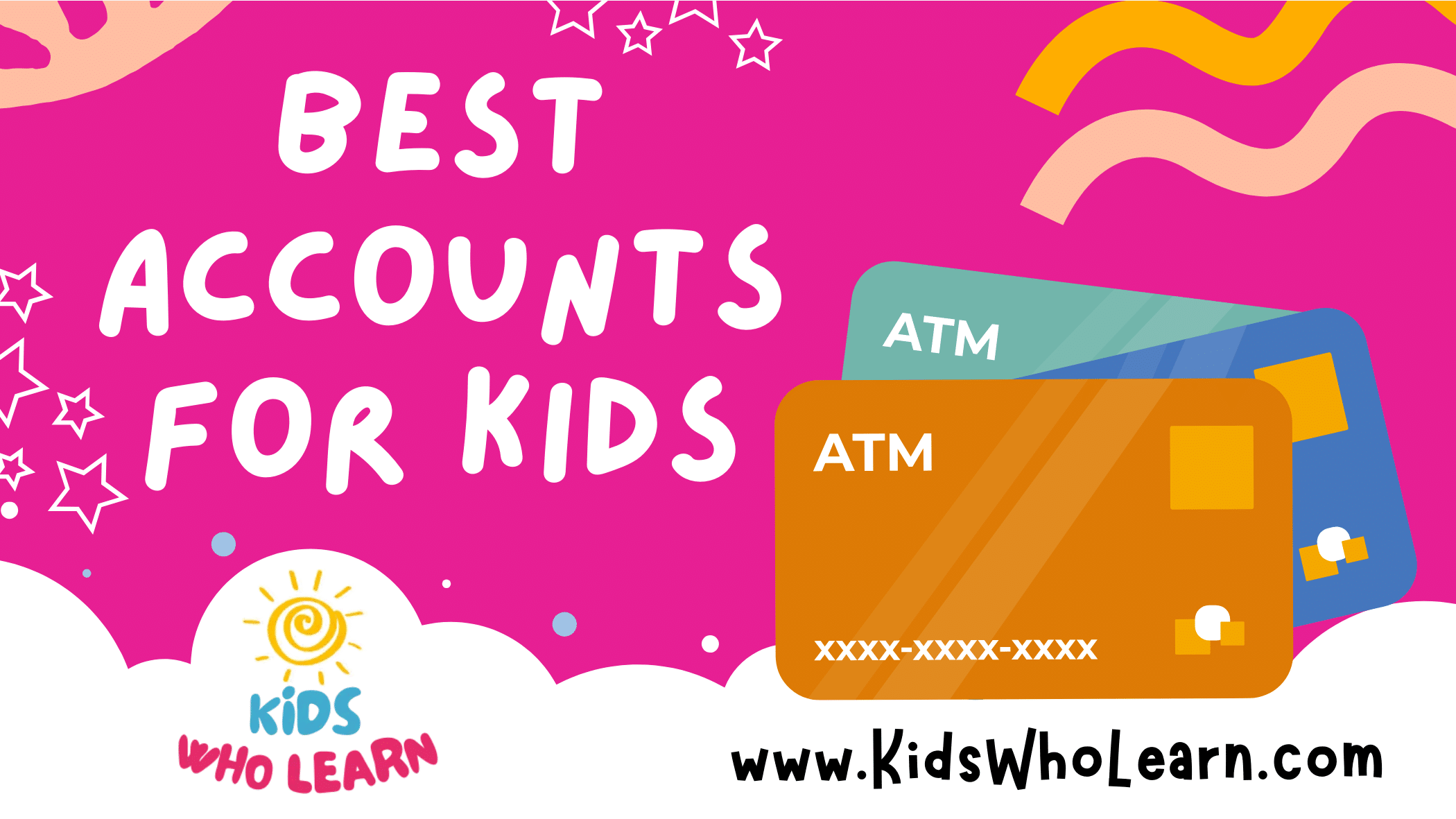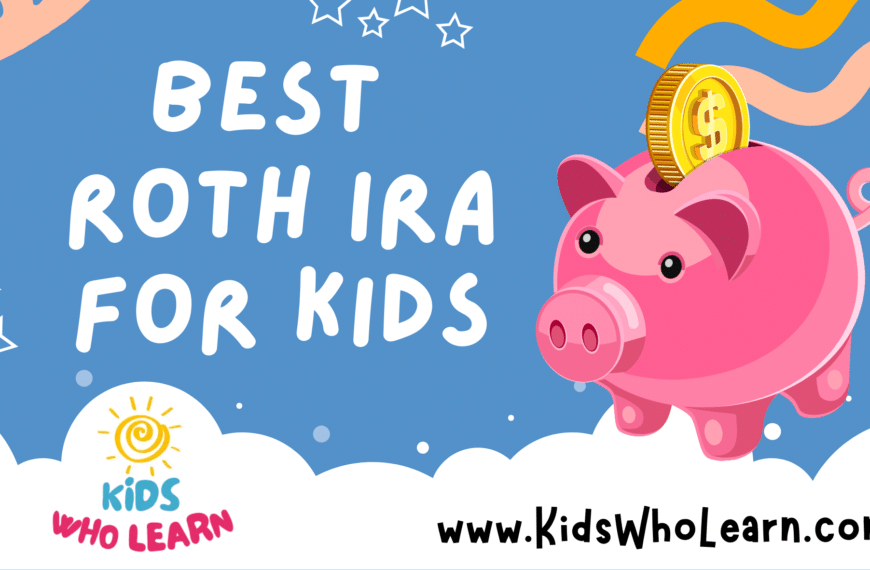Selecting the best financial accounts for children is a significant step towards teaching them about money management and savings. As guardians, it’s essential to understand the different types of accounts available and the unique features they offer that are suitable for young savers. It’s not only about finding a safe place to store money; the right account can also impart crucial financial lessons that will serve kids well into adulthood.
When exploring the options for your child’s savings account, it’s important to consider factors such as ease of access, interest rates, fees, and educational components that can support their learning journey. Additionally, assessing how these accounts can be managed and monitored will help you remain involved in your child’s financial growth without compromising their independence. Preparing children for a financially responsible future involves more than opening an account; it’s about integrating these financial tools into a broader learning framework.
Key Takeaways
- Evaluating the best accounts for kids involves assessing features relevant to young savers.
- Appropriate management and oversight options are crucial for kids’ savings accounts.
- Savings accounts for children are part of a greater financial education strategy.
Understanding the Basics of Kids’ Savings Accounts
When you’re considering a savings account for your child, it’s important to select an option that suits their age and financial goals. Kids’ savings accounts are designed to provide a safe place for minors to store their money while earning interest.
Eligibility
Typically, children under the age of 18 can open a kids’ savings account with the assistance of a parent or guardian. These accounts are a great tool for teaching financial responsibility from a young age.
| Age | Account Co-holder |
|---|---|
| Under 18 | Parent/Guardian |
Features to Look For:
- Interest Rates: Look for competitive interest rates to maximize your child’s earning potential.
- Fees: Aim to find accounts with minimal or no maintenance fees to preserve savings.
- Accessibility: Accounts should offer easy access through online banking while having safeguards in place to manage withdrawals.
Benefits:
- Financial Education: Your child will learn about banking and the importance of saving.
- Money Management: It allows them to manage their funds and watch their savings grow.
Considerations:
- Deposit Requirements: Some accounts have minimum balance requirements or initial deposit amounts.
- Account Restrictions: Verify if there are any restrictions on the number of withdrawals that can be made.
Opening the Account
You will likely need to provide personal identification for both you and your child, such as a Social Security number or birth certificate, to open the account.
By choosing the right kids’ savings account, you’re instilling a sense of financial awareness and paving the way for your child’s economic success.
Criteria for Choosing the Best Accounts for Kids
When selecting the best accounts for your kids, it’s essential to compare options based on a range of features that support their financial needs and growth.
Interest Rates and APY
Opt for accounts with the best interest rates and annual percentage yield (APY) to maximize earnings on your child’s savings. Accounts like Alliant Credit Union Kids Savings Account offer competitive APYs.
Fees and Minimum Balances
Look for accounts with no monthly fees and no minimum balance requirements. Digital banks often provide these advantages, making them cost-effective for starting out.
Ease of Use and Access
Your kids should manage their funds with ease via a mobile banking app. Products like Capital One Kids Savings Account allow simple interfacing with their services.
Educational Tools and Resources
Choose accounts that provide educational resources and games to enhance financial literacy. Traditional banks and credit unions may offer tailored savings goals tools.
Additional Features and Benefits
Extra perks like birthday bonuses or cash back can be motivating. Online banks might offer unique incentives compared to traditional banks.
Security and Safety Measures
Ensure the chosen bank takes security seriously, protecting Social Security numbers and providing parental controls on accounts like debit cards.
Reputation and Reliability
Consider the reputation and reliability of financial institutions. Both credit unions and traditional banks are known for stability and trustworthiness.
Membership and Account Types
Membership requirements vary, especially for credit unions. Evaluate whether your child qualifies for a custodial account or a teen checking account.
Incentives for Savings Growth
Accounts that offer bonuses for savings milestones are excellent for encouraging healthy financial habits. Automatic savings features can also benefit regular saving habits.
Support and Customer Service
Finally, accessible customer support is crucial. A reliable support team can assist with everything from setting up the account to resolving potential issues.
Top Savings Accounts for Kids
Selecting the right savings account can set the foundation for your child’s financial literacy and savings habits. Below, explore tailored options that combine growth potential with educational features.
High-Yield Savings Options
For maximizing earnings, Alliant Kids Savings Account stands out with competitive interest rates well above traditional accounts. Northpointe Bank offers similar high-yield options, ensuring your child’s savings grow faster.
Accounts with Educational Tie-Ins
With Sesame Street themes, PNC Bank‘s ‘S is for Savings’ account pairs saving with financial education. M&T Bank also provides materials to teach kids about money, tying in practical lessons with savings activity.
Innovative Digital and App-Based Accounts
Greenlight and gohenry are at the forefront with their app-based accounts, complete with parental controls and monitoring tools. First Internet Bank offers online banks functionality tailored for a younger audience, promoting digital convenience and financial learning.
Credit Union Kids Accounts
Pen Air Federal Credit Union and Alliant Credit Union both offer accounts specifically for minors with favorable interest rates and lower fees, often coupled with educational resources. USAlliance Financial and Spectrum Credit Union are recognized for their commitment to young members’ financial growth.
Traditional Bank Programs for Minors
Traditional banks like PNC, M&T, and Northpointe offer programs catered to minors, combining trustworthiness with age-appropriate features. These accounts typically offer stability and accessibility, with branches available for in-person banking experiences.
Account Management and Oversight
Effective account management ensures that the financial interests of your child or teen are protected and nurtured. With careful oversight, you can adapt to economic shifts and optimize for tax efficiency.
Setting Up Trust and Custodial Accounts
Trust accounts allow you to set aside funds for your child’s future under the stewardship of a trustee. When setting up a trust account, be mindful of choosing the right trustee and specifying clear terms that align with personal finance goals. A custodial account (UGMA/UTMA), on the other hand, is quite straightforward to establish; any adult can open one for a minor. These accounts can include a variety of assets, and notably, they transition to the child upon reaching the age of majority.
- Key Considerations:
- Choose trustees carefully.
- Define terms that cater to your child’s future finance needs.
- Remember, custodial accounts give control to the child at legal adulthood.
Monitoring and Adjusting for Economic Change
Constant monitoring of interest rates and economic conditions can pave the way for strategic adjustments to your child’s or teen’s account, be it a custodial, trust, or teen checking account. It’s crucial to shift funds when necessary to secure favorable interest rates or protect against economic downturns. With a joint account, you’ll have the insight to guide your teen in learning the nuances of personal finance management.
- Strategies:
- Review accounts regularly for interest rate changes.
- Adjust holdings to mitigate the impact of economic downturns.
- Educate your teen on managing a joint account during economic fluctuations.
Ensuring Tax Efficiency
Navigating the tax implications associated with your child’s accounts is vital. Unearned income in a custodial or trust account is subject to tax, and awareness of this can lead to planning that minimizes tax liabilities. It’s essential to understand the Kiddie Tax rules, which tax a child’s unearned income above a certain threshold at trust tax rates.
- Tax Planning Actions:
- Identify opportunities to reduce taxable income through smart investment choices.
- Consult with a tax professional to understand Kiddie Tax implications.
- Invest within the limits that avoid unnecessary tax burdens.
Integrating Accounts with Broader Financial Education
Incorporating accounts designed for kids into a comprehensive financial education helps establish a solid foundation for money management. This approach ensures that young savers can practice financial skills as they learn.
Teaching Money Management Skills
Financial Literacy: As a parent, you should look for accounts that offer educational resources on personal finance. Money management tutorials that cover topics like saving money and budgeting are valuable to help your child understand the flow of money and the importance of managing their finances wisely.
Budgeting: Incorporate tools that help your child to create and stick to a budget. This could include features like:
- Interactive budgeting calculators
- Visual spending trackers
By seeing where their money goes, kids can make more informed choices about their spending.
Interactive Savings Tools for Engagement
Savings Tools: Accounts should provide interactive savings tools and games that make the process of saving money engaging. Look for:
| Savings Tool | Description |
|---|---|
| Games | Interactive games focusing on financial concepts |
| Virtual saving goals | Progress trackers for virtual savings goals |
These tools help your child to connect fun activities with the habit of saving.
Engagement: Apps and accounts geared toward kids often include gamified elements that reward saving and budgeting. Positive reinforcement for making wise financial choices keeps them engaged.
Setting and Achieving Financial Goals
Financial Goals: Encourage your child to set tangible savings goals. Many accounts for kids allow them to set goals and visually track progress. This can teach patience and the satisfaction of working towards and achieving a target.
Personal Finance: Understanding the concept of saving for short-term and long-term objectives is a crucial aspect of personal finance. Offer guidance on setting realistic and achievable goals, which could be a new bike or funds for college, to show the value in saving.
Special Considerations
When choosing the best accounts for kids, it’s paramount to consider their evolving banking needs and how various accounts can support their financial journey.
Banking for Teens and Young Adults
Your teen’s checking account should grow with them, offering both savings and checking capabilities. Look for accounts that encourage savings goals with high-interest rates on savings. Many institutions provide a teen checking account with a paired debit card, enabling practical personal finance experience. Importantly, evaluate if these accounts have monthly fees; ideally, they should be low or nonexistent to maximize savings.
Services for Unique Circumstances
For kids in unique situations, such as those aging out of foster care to success, accounts with tailored services are critical. Identify financial institutions with methodology in place to handle unique circumstances, providing guidance and support.
| Feature | Importance for Unique Circumstances |
|---|---|
| Low fees | Preserves limited funds |
| Financial literacy resources | Equips with essential knowledge |
| Access to support | Offers guidance for financial queries |
Evaluating Accounts for the Long Term
Planning for the future involves looking beyond the immediate. When assessing accounts, consider long-term planning for your child’s finances. Will the account transition into a personal checking account or a credit card? Does it offer long-term planning tools for future needs? Accounts should evolve to support their journey into adulthood, ensuring that today’s financial foundation is relevant for tomorrow’s aspirations.
Practical Steps to Opening an Account
When opening a bank account for kids, it’s important to choose the right type of account and understand the process involved. Here are practical steps to follow.
Gathering Required Documentation
To open a savings account or joint account, you’ll need specific documentation. Make sure you have the child’s Social Security number and a form of identification, either for you or the child depending on the bank’s requirements. The documentation must be current and valid.
- Identification for parent/guardian:
- Driver’s license
- Passport
- Identification for child:
- Birth certificate
- Social Security card
Understanding the Account Opening Process
Understanding the banking process helps in making informed decisions. Whether choosing a digital bank or a traditional bank, inquire about the terms for a savings account. You’ll need to prepare an initial deposit or opening deposit, which varies by institution.
- Choose the appropriate account type.
- Review the account’s fees, interest rates, and terms.
- Prepare the required initial deposit amount.
Navigating Online and In-Person Banking Options
Decide if you’ll apply through an online application or prefer in-person banking. Digital banks may offer the convenience of opening an account from home, while traditional banks might provide in-person guidance.
- Online Application:
- Convenience to apply anytime
- Quick account setup
- In-Person Banking:
- Personalized assistance
- Immediate answers to questions
Setting Up Automatic Contributions
Establishing automatic savings through direct deposit can be a practical way to grow the account’s balance. Many banks offer the option to set up a recurring transfer from a checking account to the child’s savings.
- Set up automatic contributions from your account.
- Monitor the account to ensure consistent automatic savings.
Leveraging Bonuses and Rewards
Look for accounts that offer bonuses or rewards for opening an account or for setting up direct deposit. These incentives can provide additional value and encourage saving habits.
- Check for sign-up bonuses.
- Understand how to qualify for rewards.
Next Steps After Opening an Account
After you’ve opened a savings account for your child, it’s essential to establish robust financial habits early on. This sets a strong foundation for smart money management in the future.
Developing a Savings Strategy
To build savings effectively, identify specific savings goals with your child. Use a methodology that breaks down goals into manageable steps. For instance, aim to save a certain amount from their allowance every week. This could go into their piggy bank initially and then into the savings account periodically. A table can help track progress:
| Goal | Time Frame | Weekly Savings |
|---|---|---|
| New Bicycle | 6 months | $10 |
| School Trip | 12 months | $5 |
Setting up these goals encourages a consistent savings strategy which aligns with their long-term goals.
Adjusting to Financial Changes
As your child grows, they will face various economic shifts. Teaching adaptation to changes in their financial landscape is critical. If their allowance increases or decreases, help them reassess their financial planning strategy. Here’s an example of how to adjust:
- Before Increase: $5 weekly savings
- After Increase: $7 weekly savings
This teaches them the importance of being flexible and adjusting their savings plan according to their financial situation.
Incorporating Savings into Everyday Life
Incorporate savings lessons into daily activities. If your child contemplates a purchase, discuss the impact on their savings goals. A simple decision matrix can be a practical tool:
| Purchase | Cost | Effect on Goals |
|---|---|---|
| Video Game | $20 | 2 weeks delay |
| Movie Ticket | $10 | 1 week delay |
By visualizing the consequences of their spending decisions, you reinforce the importance of prioritizing financial objectives over immediate gratification. This daily practice reinforces the understanding that every financial decision impacts their savings goals.
Conclusion
Selecting the right account for your child is crucial for teaching them financial responsibility and savings habits at an early age. You’ve explored a variety of options and should now have a clear understanding of which features align with your family’s financial goals and values.
Considerations:
- Accessibility: You want an account that offers easy access for both you and your child.
- Interest Rates: Look for accounts with competitive interest rates.
- Fees: Aim for accounts with low or no maintenance fees.
- Educational Resources: Choose banks that provide educational tools to enhance your child’s financial literacy.
Next Steps:
- Research: Review the details of each potential account.
- Discuss: Talk with your child about their goals and how the account can help them save.
- Decide: Choose an account that best fits your child’s needs and your teaching objectives.
- Open an Account: Take action by setting up the chosen account.
Remember, your involvement is key to your child’s understanding of financial concepts. Your choice today has the potential to set the foundation for their fiscal responsibility for years to come.
Frequently Asked Questions
In this section, you’ll find targeted answers to common questions about children’s financial accounts, including benefits, features, and what to look for in youth-oriented banking products.
What are the benefits of a checking account specifically designed for teenagers?
A checking account for teenagers often includes parental oversight features and built-in spending limits to promote financial responsibility. These accounts can also offer educational resources tailored to help teens understand money management.
Which online savings accounts offer competitive interest rates for minors?
Several online banks provide savings accounts for minors with competitive interest rates. Look for ones that have no monthly fees, low minimum balance requirements, and online tools to track savings goals.
What should parents consider when choosing a bank for their child’s savings account?
When selecting a bank for a child’s savings account, consider the account’s fees, minimum balance requirements, interest rates, and the bank’s educational resources. It’s essential to assess how the account can grow with your child.
How do online banking features differ when they’re tailored to minors, especially regarding debit cards?
Online banking for minors usually offers customized debit cards with controlled spending and withdrawal limits. Often, they will include real-time notifications and the ability for parents to lock and unlock the card.
Are there specific types of savings accounts that are favorable for a baby’s future?
For a baby’s future, consider setting up a high-yield savings account or a custodial account under the Uniform Transfers to Minors Act (UTMA). These accounts can accrue interest over time, offering a solid foundation for future financial needs.
What advantages do 529 child savings accounts provide over regular savings accounts?
529 savings plans offer tax-free growth and withdrawals when used for qualified educational expenses. This can lead to significant savings compared to regular accounts when saving for a child’s education.














